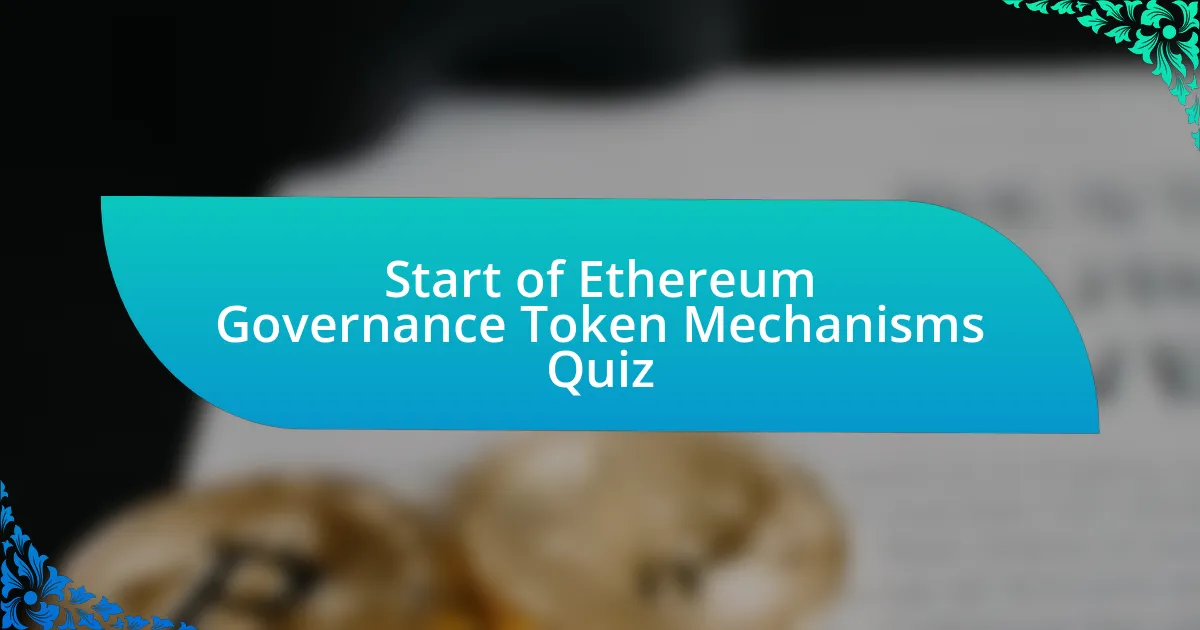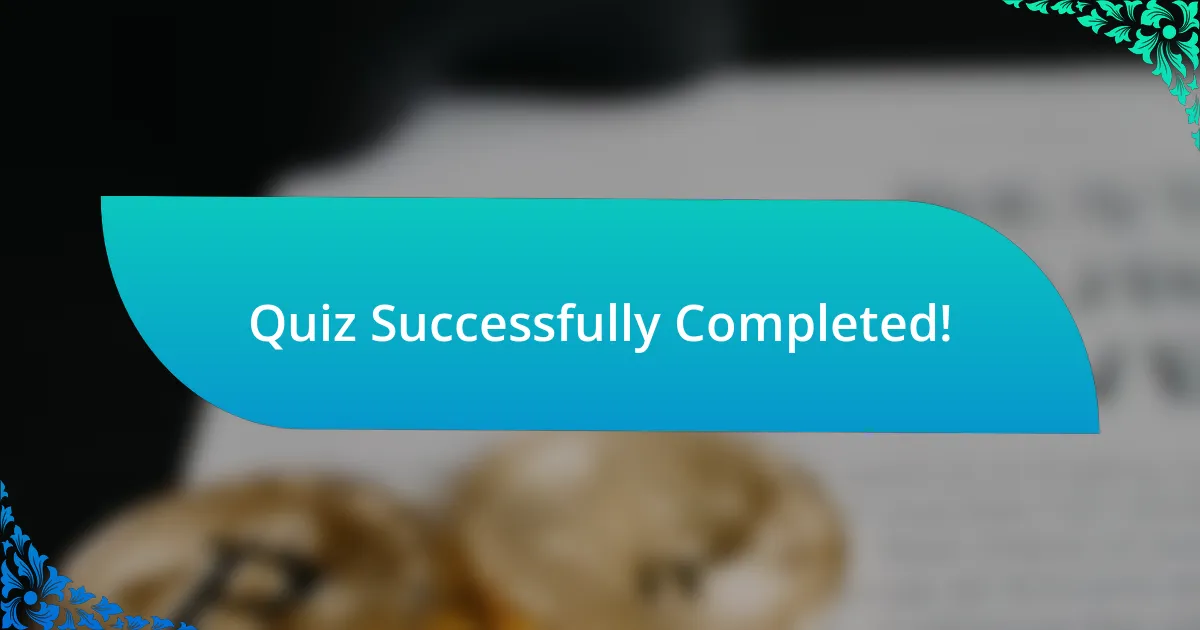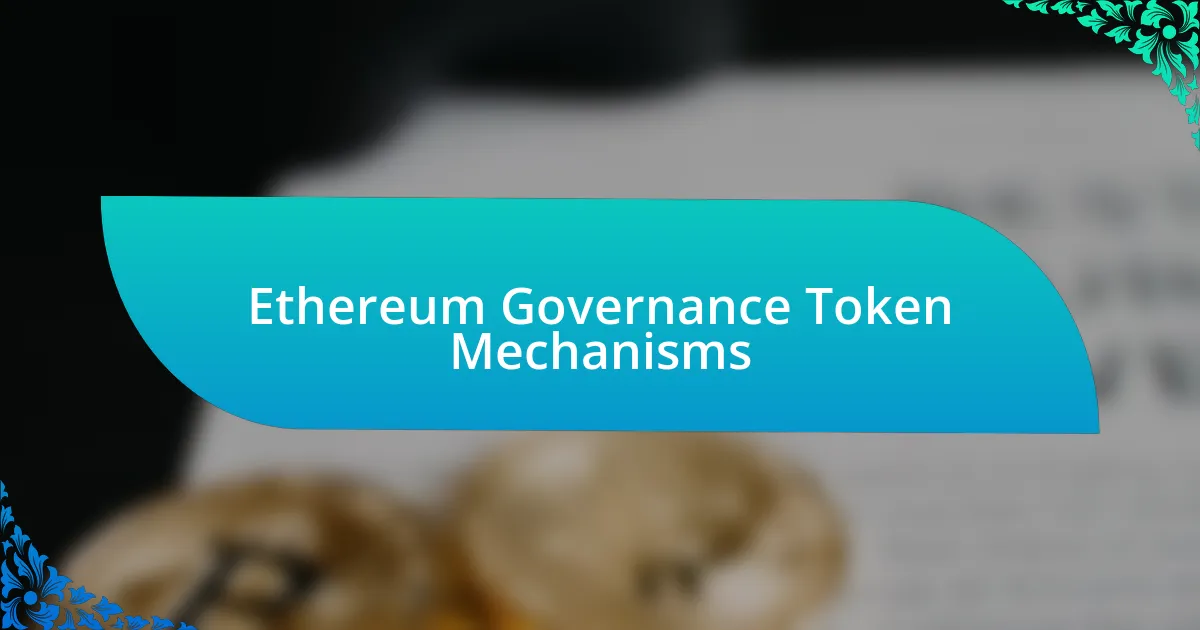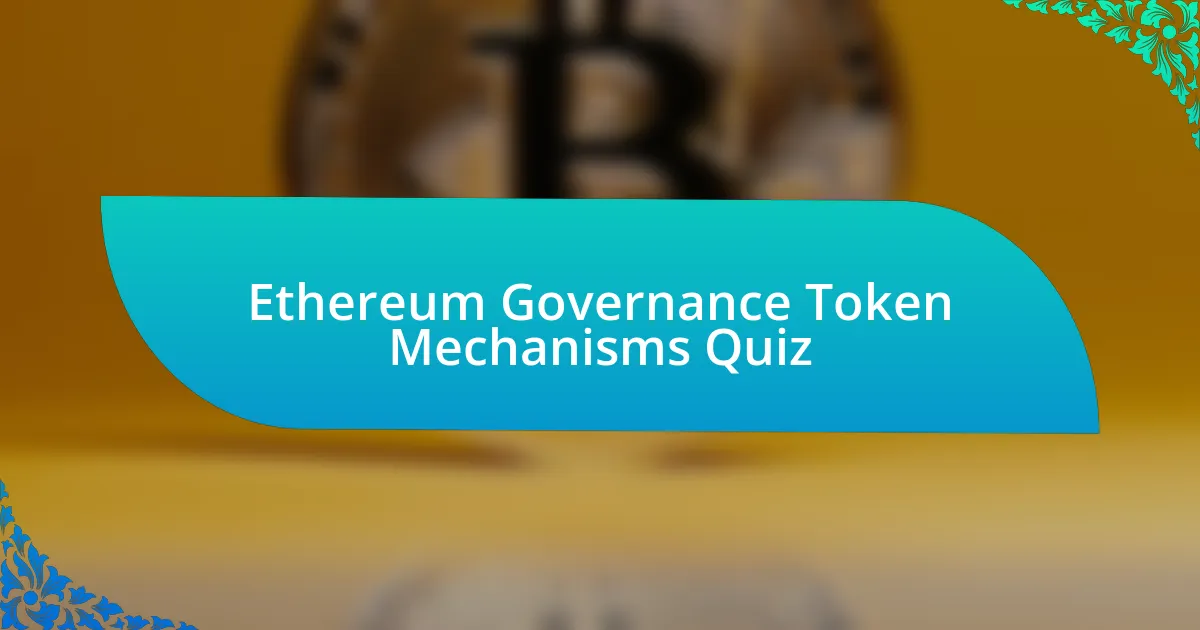
Start of Ethereum Governance Token Mechanisms Quiz
1. What is the primary role of client teams in Ethereum governance?
- Client teams are in charge of distributing Ether to users.
- Client teams conduct financial audits for Ethereum projects.
- Client teams are responsible for the development and maintenance of the main software essential for the proper functioning of the Ethereum network.
- Client teams manage marketing campaigns to promote Ethereum.
2. Who are the key players in Ethereum governance?
- Bitcoin miners
- Smart contracts
- Central banks
- Client teams
3. What is the significance of Ethereum Improvement Proposals (EIPs)?
- EIPs are mandatory rules set by the Ethereum Foundation for all developers.
- EIPs are user complaints about Ethereum transactions that are ignored.
- EIPs are reports on Ethereum’s market performance published quarterly.
- EIPs are proposals for changes to the Ethereum protocol that are discussed and implemented by client teams.
4. How do validation node operators influence Ethereum governance?
- Validation node operators solely validate transactions, with no impact on governance decisions.
- Validation node operators vote on which software versions to run, adding a tangible aspect to Ethereum’s decentralized governance.
- Validation node operators propose new tokens and manage fund allocations within the network.
- Validation node operators are responsible for enforcing legal regulations within the Ethereum framework.
5. What is the role of decentralized application (dApp) developers in Ethereum governance?
- dApp developers create new cryptocurrencies and tokens for Ethereum.
- dApp developers enforce strict rules and punishments within the Ethereum network.
- dApp developers develop features and perform upgrades based on user needs.
- dApp developers are responsible for mining new blocks and validating transactions.
6. Where are lively discussions on governance held in the Ethereum community?
- Blockchain Developer Summit
- Ethereum Community Fund
- Ethereum All Core Developers calls
- Smart Contract Expo
7. Why does Ethereum prefer off-chain governance over direct on-chain voting by ETH holders?
- To ensure all holders can vote easily.
- To prevent power centralizing among few holders.
- To reduce the need for software updates.
- To increase transaction speeds on the blockchain.
8. What are the challenges of off-chain governance in Ethereum?
- Inability to implement community feedback effectively.
- Lack of transparency and objective assessment of the decision-making process.
- High costs and resource allocation inefficiencies.
- Overreliance on automated governance mechanisms.
9. How does off-chain governance affect the legitimacy of decisions made in Ethereum?
- It allows for immediate changes to be implemented on-chain.
- The lack of traceability can raise concerns about the legitimacy of decisions made.
- It ensures that all decisions are binding and irreversible.
- It centralizes the decision-making process among top stakeholders.
10. What is the principle of “credible neutrality” in Ethereum governance?
- A system is considered credibly neutral when it favors the majority group`s preferences for governance.
- A mechanism is credibly neutral if it does not discriminate for or against any specific people, as defined by Vitalik Buterin.
- Credible neutrality is achieved when all decisions are made through a central authority in Ethereum.
- A principle is credibly neutral if it allows anyone to vote regardless of their stake in the network.
11. Who coined the concept of “credible neutrality” in Ethereum governance?
- Charles Hoskinson
- Gavin Wood
- Vitalik Buterin
- Joseph Lubin
12. What is on-chain governance in Ethereum?
- On-chain governance entails off-line discussions and analyst meetings.
- On-chain governance includes voting on the blockchain by stakeholders, usually holders of a governance token.
- On-chain governance is focused solely on user feedback through social media.
- On-chain governance refers to the analysis of market trends by financial experts.
13. How is voting done in on-chain governance?
- Voting occurs via a traditional election process managed by a board.
- Voting is done to decide whether proposed protocol changes should be implemented or not.
- Voting is organized automatically without user participation or feedback.
- Voting is conducted through secret ballots in community meetups.
14. Which decentralized autonomous organizations (DAOs) use on-chain governance mechanisms?
- Binance
- Polkadot
- MakerDAO
- Compound
15. Who can propose changes to the Ethereum protocol?
- Only wallet providers.
- EIP Authors and other stakeholders.
- Only miners.
- Central banks and governments.
16. How are disagreements handled in Ethereum governance?
- Through discussions and consensus-building processes.
- Through competitive bidding among stakeholders.
- By implementing strict rules and regulations.
- By relying solely on automated decision-making.
17. What is the role of Ether holders in Ethereum governance?
- Ether holders are responsible for network security.
- Ether holders develop new features for dApps.
- Ether holders manage the Ethereum mining process.
- Ether holders can participate in voting on proposals.
18. What is the role of developers in Ethereum governance?
- Developers manage network hardware operations.
- Developers can vote in governance.
- Developers only audit security protocols.
- Developers solely code smart contracts.
19. What is the role of miners in Ethereum governance?
- Miners propose changes to the Ethereum protocol.
- Miners manage community discussions about Ethereum upgrades.
- Miners validate transactions on the Ethereum blockchain.
- Miners create decentralized applications on Ethereum.
20. What is the purpose of Ethereum Improvement Proposals (EIPs)?
- To set a fixed gas price for all transactions.
- To propose amendments to the Ethereum protocol.
- To enforce penalties on network participants.
- To define the rules for off-chain governance.
21. How does on-chain governance make voting more approachable for different groups of stakeholders?
- By allowing anonymous votes to increase participation.
- By requiring a minimum investment to vote on proposals.
- By mandating every stakeholder to attend in-person meetings.
- By making the weight of individual contributions proportional to the number of coins held.
22. What is the advantage of formalized on-chain voting in Ethereum governance?
- It reduces transparency in decision-making.
- It limits participation to only large stakeholders.
- It makes the decision-making process more formalized, faster, and more efficient.
- It centralizes power among the developers.
23. What is an example of a decentralized application (dApp) that uses DAO governance?
- Bitcoin
- Binance Smart Chain
- MakerDAO
- Uniswap
24. How do decentralized applications (dApps) built on Ethereum use governance tokens?
- Governance tokens give unlimited access to the dApp`s source code.
- Governance tokens are used to vote on proposals to change or add something to the project.
- Governance tokens are solely for trading in the market for profit.
- Governance tokens are used to increase the transaction speed of dApps.
25. What happens when the majority agrees on a proposal in a DAO?
- The proposal is ignored completely.
- The proposal is postponed indefinitely.
- The proposal is implemented in the dApp.
- The proposal is analyzed by external parties.
26. What is the difference between on-chain and off-chain governance in Ethereum?
- On-chain governance involves direct voting on the blockchain, while off-chain governance involves discussions and agreements made outside the blockchain.
- On-chain governance relies solely on community forums, whereas off-chain governance uses smart contracts for all proposals.
- On-chain governance is a slower process requiring consensus before decisions, while off-chain governance is quick and immediate.
- On-chain governance only allows developers to vote, whereas off-chain governance includes all stakeholders.
27. Why does Ethereum use off-chain governance for some decisions?
- To centralize decision-making among developers.
- To allow quick changes without community input.
- To give more power to the largest token holders.
- To be more friendly to forks and to achieve rough consensus.
28. What are the downsides of off-chain governance in Ethereum?
- Total transparency resulting in unanimous decision-making every time.
- Unlimited amounts of funding for all proposals regardless of merit.
- Extended time of implementing new proposals and difficulty in registering input from individual community members.
- Immediate implementation of all proposed changes with full community consent.
29. How does off-chain governance work in practice?
- Stakeholders vote directly on the blockchain for immediate changes.
- Stakeholders agree on new changes to the protocol on online forums, through calls, mailing lists, or during conferences.
- Stakeholders rely solely on the client teams to implement changes without input.
- Stakeholders submit proposals that are automatically approved without discussion.
30. What is the guiding principle of Ethereum governance?
- Credible neutrality
- Token holder dominance
- Majority rule
- Centralized authority

Quiz Successfully Completed!
Congratulations on completing the quiz on Ethereum Governance Token Mechanisms! You’ve taken an important step in enhancing your understanding of how these tokens influence decision-making processes within decentralized networks. Through this quiz, you’ve likely discovered key concepts about voting rights, governance structures, and the role of token holders in shaping the future of Ethereum-based projects.
Many learners find that quizzes like this not only test their knowledge but also reinforce their understanding of complex topics. You might have gained insights into the importance of community involvement and transparency in governance models. Understanding these mechanisms can help you better navigate the evolving landscape of decentralized finance and blockchain governance.
We invite you to delve deeper into the subject by exploring the next section on this page, which offers a wealth of information on Ethereum Governance Token Mechanisms. Engaging with this content will further expand your knowledge and empower you to participate effectively in discussions about Ethereum and its governance. Happy learning!

Ethereum Governance Token Mechanisms
Overview of Ethereum Governance Tokens
Ethereum governance tokens are digital assets that grant holders the ability to participate in decision-making processes within decentralized organizations built on the Ethereum blockchain. These tokens allow users to vote on crucial matters such as protocol upgrades, changes to governance structures, and allocation of resources. The rise of decentralized finance (DeFi) and decentralized autonomous organizations (DAOs) has led to increased interest in governance tokens, as they empower community members to shape project direction.
Functionality of Governance Tokens
Governance tokens operate by enabling holders to vote on proposals, thereby influencing project development. Each token typically represents one vote, and the weight of a holder’s influence can vary based on the number of tokens owned. Proposals can cover a wide range of topics, including fee structures, future developments, and partnerships. Voting mechanisms are often encoded in smart contracts on the Ethereum blockchain, ensuring transparency and security in the process.
Popular Ethereum Governance Tokens
Several notable governance tokens exist within the Ethereum ecosystem. For example, Compound’s COMP token allows users to vote on protocol changes. Uniswap uses its UNI token for governance, enabling users to propose and vote on updates to the platform. These tokens are often tradable, allowing holders to sell or stake them while retaining voting rights. Their popularity reflects the growing trend towards community-driven development in the blockchain space.
Governance Models in Ethereum Projects
Different Ethereum projects implement varied governance models for their tokens. Some utilize a direct voting system where token holders vote on every proposal. Others adopt quadratic voting, where the cost of voting increases with the number of votes cast. Certain projects may implement delegated voting, allowing users to assign their voting power to trusted representatives. Each model has its own implications for decentralization, security, and community engagement.
Challenges of Ethereum Governance Tokens
Ethereum governance tokens face several challenges. Centralization remains a key concern, as large token holders may disproportionately influence decisions. Voter turnout is often low, leading to decisions made by a small percentage of the community. Governance attacks and manipulation, where malicious actors exploit governance systems, also pose risks. Addressing these challenges is essential for the long-term viability and effectiveness of governance tokens in shaping the future of Ethereum projects.
What are Ethereum Governance Token Mechanisms?
Ethereum Governance Token Mechanisms are systems that allow holders of governance tokens to participate in decision-making processes within decentralized organizations or projects built on the Ethereum blockchain. These mechanisms enable token holders to propose, vote on, and implement changes to protocols, funding allocations, and other significant aspects of the network. For instance, projects like Maker and Compound utilize governance tokens to grant users voting rights on key issues, thus facilitating community-led governance.
How do Ethereum Governance Token Mechanisms work?
Ethereum Governance Token Mechanisms work by enabling token holders to engage in voting processes related to governance proposals. Each token typically represents one vote, allowing holders to influence decisions proportional to their stake. Proposals are submitted for consideration, and once a voting period begins, token holders can cast their votes to approve or reject them. This structure promotes decentralized decision-making and mitigates the risks associated with centralized governance.
Where are Ethereum Governance Tokens typically used?
Ethereum Governance Tokens are typically used within decentralized finance (DeFi) platforms, decentralized autonomous organizations (DAOs), and various blockchain projects that require community input for governance. Examples include platforms like Uniswap, Aave, and MakerDAO, where governance tokens facilitate discussions and decisions regarding protocol upgrades, fee structures, and other essential changes.
When did Ethereum Governance Token Mechanisms emerge?
Ethereum Governance Token Mechanisms emerged around 2017, coinciding with the rise of decentralized applications (dApps) and DeFi projects on the Ethereum blockchain. The introduction of governance tokens became more prominent in 2020 with the launch of several DeFi protocols, which aimed to foster community engagement and democratic decision-making in protocol management, evidenced by the launch of Compound’s governance token, COMP, in June 2020.
Who benefits from Ethereum Governance Token Mechanisms?
Participants in decentralized projects benefit from Ethereum Governance Token Mechanisms, particularly token holders, developers, and the broader community. Token holders gain a voice in governance decisions, giving them direct influence over the future of the project. Developers benefit from clearer stakeholder preferences, while the community enjoys a more equitable structure for managing protocol changes and funding initiatives, thereby fostering a collaborative environment.

